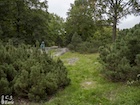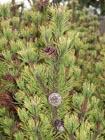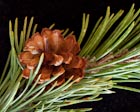Conservation Status

Pinus mugo
Turra (1764)
Common names
Dwarf mountain pine [English], Krivulj, planinski bor [Serbian], Klek [Bulgarian], Klec [Czech], Сосна стланиковая европейская [Russian], Bergkiefer, Krummholzkiefer, Bergföhre [German], Pin des montagnes [French], pino montano, pino mugo [Italian] (Jovanovic 1986, Businský 1998, M.P. Frankis field notes, Bulgaria 1998), sosna kosa, kosodrzewina [Polish].
Taxonomic notes
Type: Italy, Alto Adige, Vicenza, Monte Baldo, J. F. Seguier s.n. (lectotype NIMES). POWO lists 89 synonyms.
There are currently no recognized varieties or subspecies, but there are several named nothospecies:
- Pinus × celakovskiorum Asch. & Graebn. is the hybrid with P. sylvestris.
- Pinus × ascendens Businský is the hybrid with P. uncinata.
- Pinus × ascendens nothosubsp. ascendens is the hybrid with P. uncinata subsp. uncinata.
- Pinus × ascendens nothosubsp. skalickyi Businský is the hybrid with P. uncinata subsp. uliginosa.
Natural hybrids are also recorded with P. nigra and P. heldreichii.
This is a member of Pinus subsection Pinus, a large section comprised mostly of Eurasian 2-needle pines. Pinus mugo and Pinus uncinata have been treated as either two species, or as two subspecies of P. mugo, for most of the past 200 years; there has never been clear agreement on this point. Formerly morphological, and now molecular analyses have established that they are sister species (Sokołowska et al. 2021). Recent comprehensive reviews of the conifers by Eckenwalder (2009) and Debreczy and Racz (2011) maintain subspecies status for P. uncinata, while Farjon (2010) grants it species status, and so it most often appears in current literature. There is a complexity resulting from this; many collections of P. mugo have been made without declaring the specimen to be of the "mugo" type or the "uncinata" type; see the map below.
My review of the literature on the Pinus mugo complex, which also includes (in this treatment) P. uncinata and many populations of both taxa introgressed by P. sylvestris, leads to the conclusion that the complex is, in fact, very complex. A great many populations are distinctive in both morphological and molecular markers and nearly every investigator has chosen a different way of dividing the complex, such that over a hundred taxa have been named; but assigning any given individual to one of these is often impractical as confident identification requires assessing a statistically significant number of samples with regard to a substantial number of characters. From a practical point of view, the operational questions are, is it a tree or a shrub? Is it in a bog or an upland? Is it in the high mountains or not? Which mountain range, which country? Answering these questions will generally lead to a correct answer at species or subspecies rank, and only long experience with the taxa will enable accurate identification of the numerous and common hybrids.
Description
Shrub 1-3(-5) m tall, with one or more curved trunks; branches long, base laying on the ground (up to 10 m from base), with ± ascending or erect major branch ends; rarely a tree. Bark thin, ash-gray-brown to blackish-grey, splitting in angular scaly plates on old stems. Shoots uninodal, glabrous, greyish-black to deep red-brown grooved between the decurrent scale-leaves. Buds ovoid-conic, 6-9 mm, red-brown, very resinous. Leaves in fascicles of two (rarely three around apical bud of strong shoots), bright to dark green, often with a greyish tinge, straight to slightly twisted, minutely serrulate, 23-75 mm long, 0.9-2.1 mm wide, leaf sheath persistent, grey, 15-18 mm. Leaves persistent (2-)4-9(-10) years. Plants usually monoecious, rarely subdioecious. Male cones 10 mm, yellow or red, pollen shed May to July. Female cones purple ripening matte dark brown in late September to October 15-17 months later and opening then, or (if covered by winter snow first) the following spring; sessile or nearly so, symmetrical, 18-55 mm long, 14-28 mm wide (closed), opening to 25-45 mm, angle of inclination to stem 90°-130°; apophysis thin, flat, flexible, 6-10 mm wide and 1-2 mm thick, rhomboidal with a sharp transverse keel, rarely moderately thickened to pyramidal; umbo central, 3-4 mm wide. Seed black, 3-4 mm with a 7-12 mm wing buff with darker streaks; cotyledons (3-)5-7(-8). Cones shed soon after seed release or up to a year or two later. (Jovanovic 1986, Christensen 1987, M.P. Frankis, field notes and herbarium material, Bulgaria 1998). See García Esteban et al. (2004) for a detailed characterization of the wood anatomy.
Comparing P. mugo and the two subspecies of P. uncinata (Sokołowska et al. 2021):
- P. mugo is a shrub with long, curved branches, reaching up to 3.5 m in height; also it is generally a high mountain species, found at 1600-2200 m elevation.
- P. uncinata subsp. uliginosa is usually a tree to 7 m tall, found in peat bogs.
- P. uncinata subsp. uncinata is a tree reaching at maturity 12–20 m tall.
Distribution and Ecology
Albania, Austria, Bosnia & Herzegovina, Bulgaria, Croatia, Czechia, France, Germany, Italy, Macedonia, Montenegro, Poland, Romania, Serbia, Slovakia, Slovenia, Switzerland, and Ukraine. It grows at altitudes of 1400-2500(-2700) m in the high subalpine region at and above the timberline (Jovanovic 1986, Christensen 1987). Highest altitudes are reached in the extreme S of its range in the Pirin Mts of SW Bulgaria, where it reaches at least 2700 m (M.P. Frankis field notes and herbarium material, Bulgaria 1998). P. mugo is naturalized in Canada: Alberta, British Columbia, Ontario, and Québec; and the USA: Massachusetts, Michigan, Minnesota, New Hampshire, and Wisconsin (PLANTS database 2009.03.31). Although this widespread species is not of conservation concern, P. mugo is rare in Croatia, and is protected by law. Hardy to Zone 3 (cold hardiness limit between -39.9°C and -34.4°C) (Bannister and Neuner 2001).
Distributions of P. mugo and P. uncinata. P. mugo includes "P. mugo s.s." which are specimens synonymous with P. mugo, and "P. mugo s.l." which are specimens that could be assignable to either P. mugo or P. uncinata. Due to the large number of records (over 50,000) data have been subsampled to 0.1 degree spatial resolution. Source, GBIF.org (2021.11.12) GBIF occurrence download https://doi.org/10.15468/dl.348a34.
Remarkable Specimens
The oldest known specimen, 283 years, was documented in a tree-ring chronology covering the period 1681-2008 (fully crossdated), collected in Swiss National Park, Grisons, Switzerland by Christof Bigler (doi.org/10.25921/wyqz-ag79). This tree's record ended in 1977, so it was presumably dead; two living trees provided a 255-year record. Only two chronologies have been developed for this species, and older trees likely exist. This site was used in a study of P. mugo mortality (Bigler and Rigling 2013).
Ethnobotany
Used to protect soil against erosion and to retard avalanching. Wood hard, heavy. Needles are the source of oil (Jovanovic 1986), and are also used for a (delicious!) herbal tea in Bulgaria (M.P. Frankis field notes, Bulgaria 1998). As an ornamental it is very popular with rock and landscape gardeners, particularly in Scadinavia, Holland and Germany, where it is widespread in municipal parks and gardens (Businský 1998; M.P. Frankis, pers. obs.). USDA hardiness zone 4.
Observations
Very easy to see around the top stations of ski lifts in Austria, Bulgaria and elsewhere in central and SE Europe; it is usually abundant and covers large areas at and above the treeline.
Remarks
The epithet is an Italian vernacular name for this pine.
Species of the P. mugo complex show some striking similarities to P. contorta and P. banksiana of North America, including extensive occurrence at and near the alpine treeline, growth on strongly nutrient-limited sites, adaptation to highly acid wetland soils including peat bogs, short needles combined with small cones and seeds, and a shrub or small tree growth form. Since their evolutionary tracks diverged at the start of the Eocene with the divergence of Sections Pinus and Trifoliae (Jin et al. 2021), these commonalities must represent convergent evolution.
The low shrubby growth with a bowed basal section of stem is an adaptation to deep snow cover and avalanches; the erect branch ends are flattened down by the weight of snow, to spring erect again during the spring thaw; see Berkutenko (1993) for a discussion of this phenomenon with regard to the similar growth structure of Pinus pumila. The Bulgarian name Klek ('knee') refers to the growth form.
Very rarely plants with cone characters of subsp. mugo make small trees with a straight stem, but only where sympatric with either subsp. uncinata or hybrids with it, suggesting tree form is due to hybrid influence (Christensen 1987).
Citations
Berkutenko, A. 1993. The remarkable Pinus pumila. Int. Dendrol. Soc. Yearbook 1992: 41-46.
Bigler, Christof and A. Rigling. 2013. Precision and accuracy of tree-ring-based death dates of mountain pines in the Swiss National Park. Trees - Structure and Function. http://dx.doi.org/10.1007/s00468-013-0917-6.
Businský, R. 1998. Pinus mugo agg. in former Czechoslovakia - taxonomy, distribution, hybrid populations and endangering. Zprávy Ces. Bot. Spolec. Praha 33: 29-52. [in Czech; brief English summary].
Christensen, K.I. 1987. Taxonomic revision of the Pinus mugo complex and P. × rhaetica (P. mugo × sylvestris) (Pinaceae). Nordic J. Botany 7: 383-408.
Jin, Wei-Tao, David S. Gernandt, Christian Wehenkel, Xiao-Mei Xia, Xiao-Xin Wei, and Xiao-Quan Wang. 2021. Phylogenomic and ecological analyses reveal the spatiotemporal evolution of global pines. Proceedings of the National Academy of Sciences 118(20):e2022302118. doi.org/10.1073/pnas.2022302118.
Jovanovic, Branislav. 1986. "Pinus mugo" in Flora Srbije. Belgrade: Serbian Academy of Sciences and Arts.
Sokołowska, Joanna, Hanna Fuchs, and Konrad Celiński. 2021. New insight into taxonomy of European mountain pines, Pinus mugo complex, based on complete chloroplast genomes sequencing. Plants 10(7):1331. doi.org/10.3390/plants10071331.
Turra, A. 1764. Dei vegetabili di Monte Baldo. Giorn. Italia Sci. Nat. 1:152.
See also
Elwes and Henry 1906-1913 at the Biodiversity Heritage Library (P. mugo treated as P. montana). This series of volumes, privately printed, provides some of the most engaging descriptions of conifers ever published. Although they only treat species cultivated in the U.K. and Ireland, and the taxonomy is a bit dated, still these accounts are thorough, treating such topics as species description, range, varieties, exceptionally old or tall specimens, remarkable trees, and cultivation. Despite being over a century old, they are generally accurate, and are illustrated with some remarkable photographs and lithographs.




